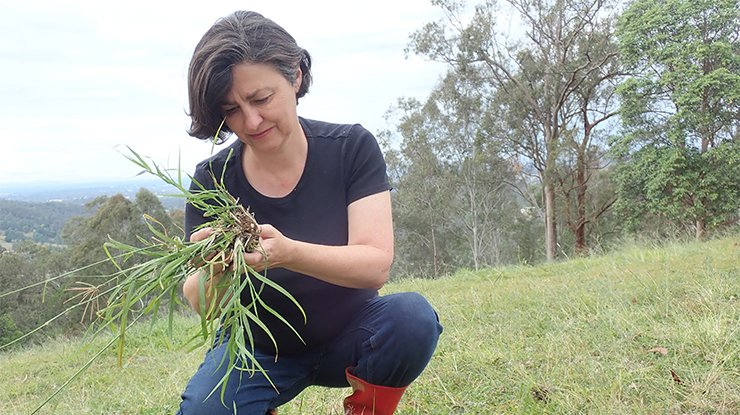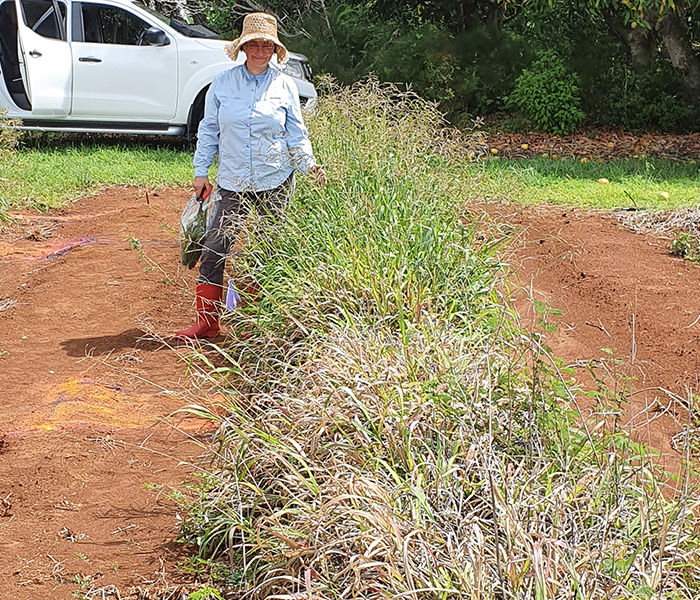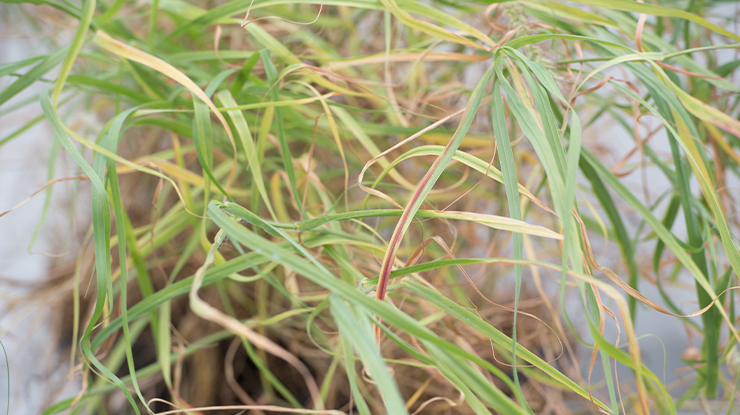 Dr Caroline Hauxwell, Queensland University of Technology, inspecting pasture at a property in Queensland. Image: Queensland University of Technology
Dr Caroline Hauxwell, Queensland University of Technology, inspecting pasture at a property in Queensland. Image: Queensland University of Technology
DID YOU KNOW? The red meat and livestock industry is working in close collaboration to respond to the on-farm challenges presented by pasture dieback. MLA, Queensland Department of Agriculture and Fisheries and New South Wales Department of Primary Industries are working alongside red meat producers, research institutions, peak industry councils and state farming organisations to ensure ongoing investment in pasture dieback research is effective, well-coordinated and clearly communicated. |
Having spread rapidly in recent years, pasture dieback is an increasing concern for producers in Queensland and northern NSW.
Although the cause of pasture dieback is still unknown, research has indicated that mealybugs are commonly associated with the condition.
In response to this, MLA is using a grant from the Department of Agriculture, Water and the Environment to fund three research projects being conducted by the Queensland University of Technology which are investigating the possible role of mealybugs in causing pasture dieback.
Dr Caroline [Carrie] Hauxwell is an Associate Professor at QUT and leads these projects. Here, she outlines the projects, what has already been determined about mealybugs and their relationship to pasture dieback, and how this research is informing management strategies.
Project one: Determining the role of the mealybug in pasture dieback
There’s strong evidence to suggest mealybugs could be playing a role in the cause of pasture dieback seen in Queensland and northern NSW; however, the issue is likely to be more complex than one single causal agent.
“There are a lot of things out there that kill grasses, but our research into the mealybug Heliococcus summervillei, as well as historical records of its presence in Queensland causing dieback as early as 1926, strongly indicate they might be a working agent in dieback,” Carrie said.
“We’re looking at how mealybugs kill grasses and running tests on possible controls. The treatment will also provide insights into whether the mealybug causes dieback by observing if the grass recovers or not.
“We found that pasture grass in small plot trials recovers and mealybug numbers decline when sprayed with Movento® (spirotetramat), for example.”
Understanding the mealybug biology in project two will be critical to developing management strategies to control the insect and avoiding the financial and environmental impacts of chemical overuse.

Dr Carrie Hauxwell inspecting Urochloa oligotricha affected by mealybug-induced dieback in an insecticide spray trial. The grass in the foreground is untreated, while the grass next to Carrie has been treated with Movento. Image: Queensland University of Technology.
Project two: Understanding the biology of the mealybug and its natural enemies
“This project aims to get a grip on generation times, grass preferences, seasonality and the natural enemies of the mealybug,” Carrie said.
Establishing the life history of the mealybug and under different seasons will support future research on mitigating their impacts.
“We already know that the mealybugs behave differently as adults and as early instars, and may require different insecticides to target different life stages.
“The damaging early instars feed on roots and deep in foliage and require a systemic insecticide such as Movento to manage them, while reproductive adult females don’t appear to feed but do migrate on the surface and may respond to conventional contact insecticides.”
There are currently no contact insecticides registered for the control of the pasture mealybug, but research such as this will be fundamental to developing future management strategies.

Buffel grass affected by pasture dieback. Image: Queensland University of Technology.
Project three: Identifying resistant grass varieties to mealybugs
“We’re looking for grasses that have survived repeat attacks from the mealybug, and also those that are susceptible,” Carrie said.
“So far, no grasses have been found to be resistant, but farmers have reported small clumps of plants and paddocks have been shown to survive attacks, so we are very interested to identify why this is.
“This project also looks into the role of endophytes and doing a proof of concept to show they can impact the mealybug.”
Endophytes are organisms such as bacteria or fungi that can live within plants without causing disease.







